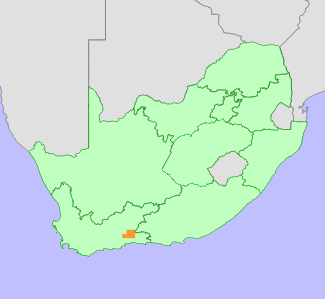|
Scientific Name | Syringodea derustensis M.P.de Vos |
Higher Classification | Monocotyledons |
Family | IRIDACEAE |
National Status |
Status and Criteria | Vulnerable B1ab(ii,iii,iv,v)+2ab(ii,iii,iv,v) |
Assessment Date | 2022/10/18 |
Assessor(s) | J.H. Vlok & D. Raimondo |
Justification | A range-restricted species, with an extent of occurrence (EOO) of 1717 km² and area of occupancy (AOO) of 48 km². It is known from 10 locations. and has experienced past loss due to urban expansion and crop cultivation around De Rust and to dam construction in Dysselsdorp. Decline is ongoing due to informal housing expansion around De Rust. This species is also potentially threatened by ostrich farming. It is therefore listed as Vulnerable under criterion B. |
Distribution |
Endemism | South African endemic |
Provincial distribution | Western Cape |
Range | This species is endemic to the Western Cape Province, South Africa, where it occurs from Oudtshoorn to De Rust. |
Habitat and Ecology |
Major system | Terrestrial |
Major habitats | Mons Ruber Fynbos Thicket, Gamka Valley Thicket, Oudshoorn Karroid Thicket, Muscadel Riviere |
Description | It grows in stony washes on quartzite slopes in succulent karoo, fynbos and thicket vegetation. |
Threats |
| Major populations around De Rust were exterminated by urban and agricultural developments in the past, it also lost habitat and a subpopulation to Dam building in Dysselsdorp. Subpopulations around De Rust are still declining as the commonage is not well managed and part of the land has recently been lost through (illegal) informal housing (J. Vlok 2008 pers. comm.). The other subpopulations on private land are potentially threatened by the ostrich industry. |
Population |
Although there is very little information available on the population size of this species, habitat loss from agricultural practices, urban development, and informal settlements is believed to be the primary cause of its decline.
|
Population trend | Decreasing |
Assessment History |
Taxon assessed |
Status and Criteria |
Citation/Red List version | | Syringodea derustensis M.P.de Vos | VU B1ab(ii,iii,iv,v) | Raimondo et al. (2009) | | Syringodea derustensis M.P.de Vos | Vulnerable | Hilton-Taylor (1996) | | Syringodea derustensis M.P.de Vos | Rare | Hall et al. (1980) | |
Bibliography |
De Vos, M.P. 1983. Syringodea, Romulea. In: O.A. Leistner (ed). Flora of Southern Africa 7 Iridaceae, Part 2 Ixioideae, Fascicle 2:1-73. Botanical Research Institute, Pretoria.
Goldblatt, P. and Manning, J.C. 2000. Cape Plants: A conspectus of the Cape Flora of South Africa. Strelitzia 9. National Botanical Institute, Cape Town.
Goldblatt, P. and Manning, J.C. 2020. Iridaceae of southern Africa. Strelitzia 42. South African National Biodiversity Institute, Pretoria.
Hall, A.V., De Winter, M., De Winter, B. and Van Oosterhout, S.A.M. 1980. Threatened plants of southern Africa. South African National Scienctific Programmes Report 45. CSIR, Pretoria.
Hilton-Taylor, C. 1996. Red data list of southern African plants. Strelitzia 4. South African National Botanical Institute, Pretoria.
Raimondo, D., von Staden, L., Foden, W., Victor, J.E., Helme, N.A., Turner, R.C., Kamundi, D.A. and Manyama, P.A. 2009. Red List of South African Plants. Strelitzia 25. South African National Biodiversity Institute, Pretoria.
Vlok, J. and Schutte-Vlok, A.L. 2010. Plants of the Klein Karoo. Umdaus Press, Hatfield.
|
Citation |
| Vlok, J.H. & Raimondo, D. 2022. Syringodea derustensis M.P.de Vos. National Assessment: Red List of South African Plants version 2024.1. Accessed on 2025/12/07 |
 Comment on this assessment
Comment on this assessment


